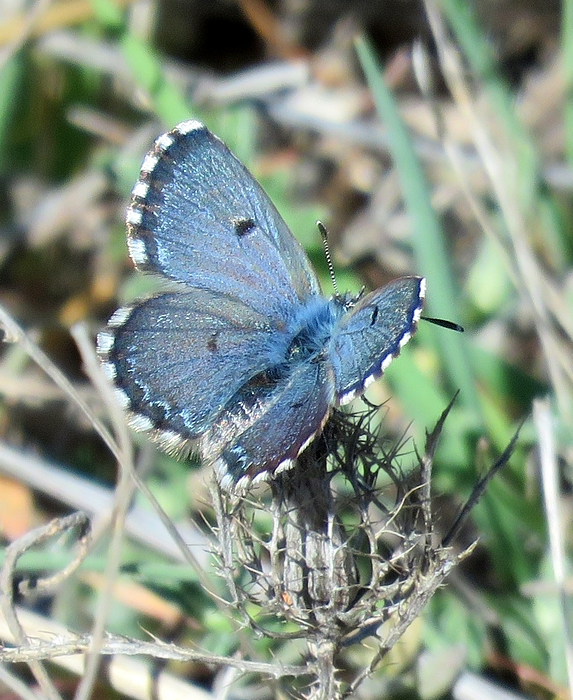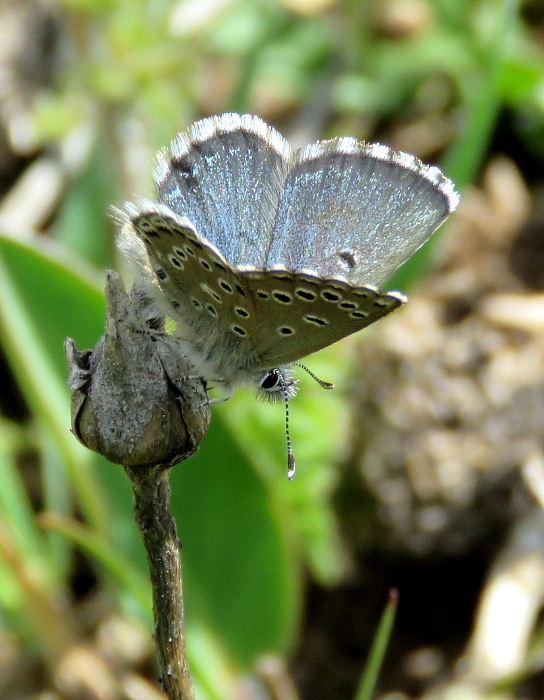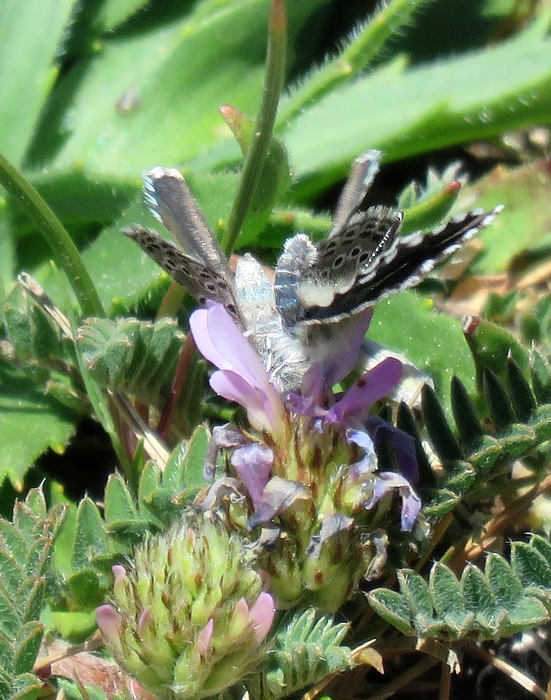
Male, Antequera, April 2019

Male, Antequera, April 2023

Male, Antequera, April 2019

Female (I think), Antequera, April 2023

Female, Antequera, April 2023

Female, Antequera, April 2023

Male, Antequera, April 2019

Male, Antequera, April 2019

Female, Antequera, April 2019

Female, Antequera, April 2019

Female, Antequera, April 2019

Male attempting (and ultimately failing) to couple with a female, Antequera, April 2023

Detail of fringe showing 'T' shape of black marks, male, Antequera, April 2019

I think these are the leaves of the foodplant, Cleonia lusitanica, but none were in flower at the time.

Distribution
The smallest member of its
genus, this
tiny butterfly is restricted to North Africa and the southern half of
Iberia, where it has a rather patchy distribution. In North Africa it
is said to be bivoltine but in Portugal and Spain there is just one
brood, which flies in April and May. I think I was quite lucky to come
across a colony near Antequera on 3rd April 2019, in what seems to have
been an exceptionally early spring in Andalucía. Normally I visit this
part of the world in February and March and have never come across this
species before.
In form and general appearance, the false baton blue (a silly name - there is nothing false about it) is like a diminutive baton blue. The male is darker, with more dark suffusion towards the edges of the wings and in both sexes there is only vestigial submarginal orange on the underside. In fact, there is no overlap in distribution with baton blue, so no confusion with this species should ever arise. Its distribution does, however, overlap with that of the Panoptes blue, the Iberian counterpart of baton (which I have yet to see). Like the false baton blue, the Panoptes blue has little or no orange beneath, but the two species are easily distinguished. The upperside forewing discal spot of false baton is clearly edged in pale, while that of Panoptes has at best a slight hint of pale around it, and the blue of false baton is deeper. The wing fringes are distinctly different on the underside (and to a lesser degree on the upperside). In false baton blue the dark chequering is significantly broader in the outer half of the fringe, giving rise to a 'T' effect, clearly shown in my last image above. In Panoptes it is equally broad in both halves of the fringe, or even broader in the inner half. Finally, the inner black spots in the submarginal markings of the underside hindwing are rather flat and elongate in false baton but distinctly triangular or crescent-shaped in Panoptes. Given a good view, it is easy to be confident identifying the present butterfly.
In North Africa, the false baton blue uses thyme as a foodplant, like other baton blues, but in Spain (and I presume Portugal, though the books are not clear on this) it takes a quite different plant, Cleonia lusitanica. I searched in the rain on 6th April 2019, at the site where I had found the adults on 3rd, and found what I think are the leaves of this plant. If I am right, it was quite common just there, but no plants were in flower. Tolman says eggs are laid on the underside of leaves but that the caterpillars spend their whole lives feeding in the flowers. If I am right in identifying the plant, it must come into flower while the first eggs laid are maturing. It hibernates as a pupa.
In form and general appearance, the false baton blue (a silly name - there is nothing false about it) is like a diminutive baton blue. The male is darker, with more dark suffusion towards the edges of the wings and in both sexes there is only vestigial submarginal orange on the underside. In fact, there is no overlap in distribution with baton blue, so no confusion with this species should ever arise. Its distribution does, however, overlap with that of the Panoptes blue, the Iberian counterpart of baton (which I have yet to see). Like the false baton blue, the Panoptes blue has little or no orange beneath, but the two species are easily distinguished. The upperside forewing discal spot of false baton is clearly edged in pale, while that of Panoptes has at best a slight hint of pale around it, and the blue of false baton is deeper. The wing fringes are distinctly different on the underside (and to a lesser degree on the upperside). In false baton blue the dark chequering is significantly broader in the outer half of the fringe, giving rise to a 'T' effect, clearly shown in my last image above. In Panoptes it is equally broad in both halves of the fringe, or even broader in the inner half. Finally, the inner black spots in the submarginal markings of the underside hindwing are rather flat and elongate in false baton but distinctly triangular or crescent-shaped in Panoptes. Given a good view, it is easy to be confident identifying the present butterfly.
In North Africa, the false baton blue uses thyme as a foodplant, like other baton blues, but in Spain (and I presume Portugal, though the books are not clear on this) it takes a quite different plant, Cleonia lusitanica. I searched in the rain on 6th April 2019, at the site where I had found the adults on 3rd, and found what I think are the leaves of this plant. If I am right, it was quite common just there, but no plants were in flower. Tolman says eggs are laid on the underside of leaves but that the caterpillars spend their whole lives feeding in the flowers. If I am right in identifying the plant, it must come into flower while the first eggs laid are maturing. It hibernates as a pupa.